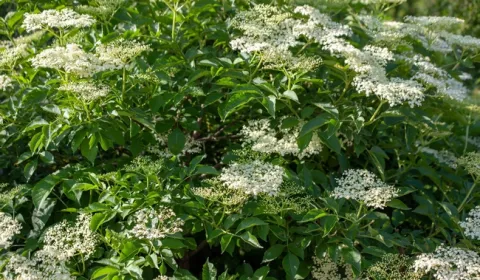Elderberry

Elderberry
By Jutta Thoerner UCCE Master Gardener
Sambucus nigra subspecies caerulea syn. Sambucus mexican
Size of tree: 10-25 feet high and wide.
PH: 5-9, will tolerate alkaline soils
USDA hardy zone: 6-10
Bloom description and season: flat topped clusters of tiny, creamy-white flowers. March- June depending on your location. Fragrant, a sweet scent.
Pruning needs: heavy pruning in winter, only necessary if a trimmed look is desired
Exposure: sun to partial shade.
Water needs: moderate drought tolerant, Watering produces more flowers and berries.
While growing up in Germany, it seemed that everybody in the countryside had an elderberry tree in their yard. We enjoyed the berries in jams and jellies and got dried berries or flowers as a tea remedy for various ailments. I was surprised to see the CA version growing in the hot Central Valley and all over the Central Coast. I learned that Native Americans used the berries for food and purple dyes, the bark and flowers for anti-inflammatory, diuretic and laxative properties. Now I know that the elderberry adapts to all types of soil, from sandy to loam, from acid to very alkane soil. It is fast growing and does well in semi shade and sun, but give it room to spread a bit. Because it is a semi drought plant, too much competition from other trees or shrubs and the flower show is short and the berries will dry up before they mature. In which case, keep the elderberry watered in hot dry climates well into the summer. If you like a more tidy appearance in your garden, prune it back hard in the winter. Did you inherit an unruly specimen? Then you can cut it back all the way to the ground and start over with the shaping of the tree. Don't like spraying for pests in your garden? There is a good reason why our organic farmers are planting elderberries as hedgerows. The flowers will attract a host of beneficial insects, the green lace wing is one of them and its favored diet is aphids and spider mites. The abundant flowers and berries serve as food for many insects and birds, if you can resist cooking the berries for jam, syrup or wine. So with a nice, sunny open spot in your garden, give the elderberry a try, you won't regret it.
We are still here!!!
No in-person workshops for now, but you can view workshops on:
Instagram live at slo_mg or visit our You Tube channel
at “San Luis Obispo County UC Master Gardeners”.
Visit our website; https://ucanr.edu/sites/mgslo/
or email us at anrmgslo@ucanr.edu
Our physical offices are closed, but you can still call or email questions:
San Luis Obispo 805-781-5939
Arroyo Grande 805-473-7190
Templeton 805-434-4105
